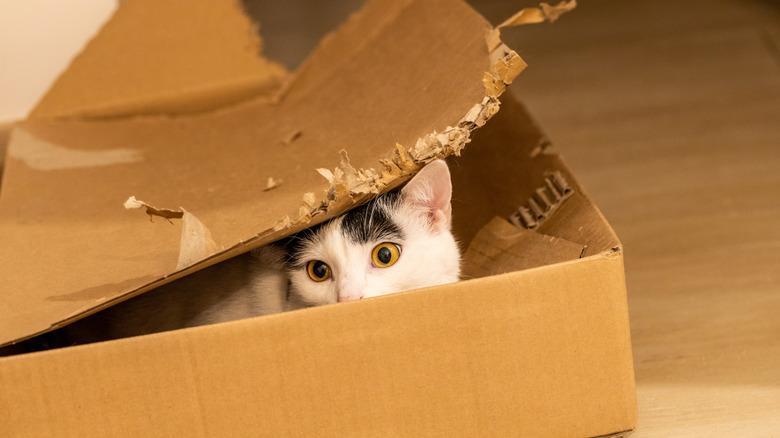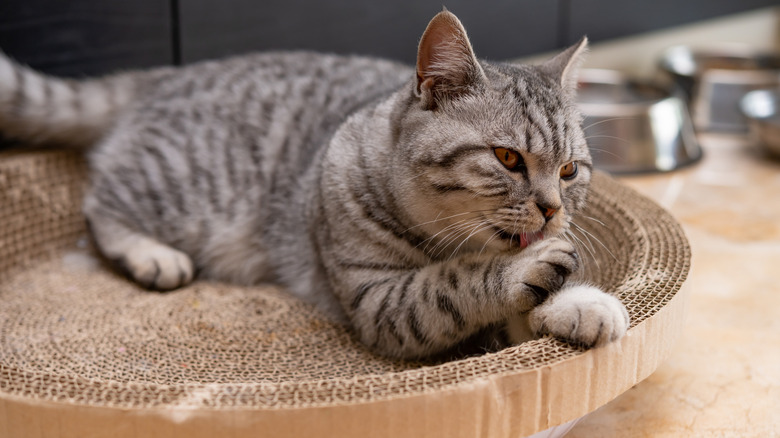This Commonly Recycled Material Makes The Best Cat Scratchers
Making a DIY cat scratcher from upcycled cardboard is a practical and sustainable project for cat owners. Felines instinctively scratch corrugated surfaces, which helps cats relieve stress and keep their claws healthy. For humans, creating a scratcher offers a way to reuse cardboard that might otherwise end up in recycling bins. Additionally, this homemade solution can help protect furniture by encouraging cats to scratch appropriate surfaces, i.e. a feline-friendly way of saying "scratch this, not that."
The traditional method of crafting a cardboard scratcher is simple and requires only a few tools: sturdy cardboard boxes, a ruler, and a utility knife. Start by aligning the cardboard so that the fluting (the wavy part) runs parallel to your cuts. Mark 1-inch strips across each sheet and cut along the lines to create uniform strips. Stack the strips tightly, applying small dots of glue between layers for stability. Rubber bands can hold the layers in place while the glue dries, resulting in a sturdy, layered scratcher. Sprinkling dried catnip on the finished product can make it more appealing to cats.
While effective, this method requires time and careful handling of sharp tools, which may deter some DIYers. Consider using a 3D-printed cardboard cutter to simplify and speed up the process without compromising results.
A streamlined approach to crafting DIY cat scratchers
Creating a DIY cat scratcher can be time-consuming, but a 3D-printed cardboard cutter offers a safer, faster alternative. This tool eliminates the need for detailed measuring and cutting, reducing the risks associated with sharp blades while maintaining the eco-friendly focus of upcycling. By aligning with the natural fluting of cardboard, the cutter allows for precise, uniform strips with minimal effort.
To use the cutter, simply slide sturdy cardboard through to produce strips of consistent width. These strips can then be stacked and glued into a stable scratcher base, just as with the traditional method but without the added hassle of manual cutting. This streamlined process makes it easier for cat owners to reuse materials creatively, even if they are new to DIY projects. And when the scratcher wears out, the cardboard strips can be recycled, completing the cycle of sustainability. If you own a 3D printer, instructions are available online for free from the likes of Kickass3DPrints and DIY enthusiasts such as Mike2121.
Customize your cat scratcher for maximum fun and durability
Using a 3D-printed cardboard cutter not only simplifies the creation of a cat scratcher but also opens up possibilities for customization. By experimenting with different cardboard types and layouts, you can tailor the scratcher to your cat's size and preferences. For instance, alternating layers of thick and thin fluting can create varying textures to keep your feline stimulated.
Additionally, the compact strips produced by the cutter make it easy to create scratchers in unique shapes or sizes, such as a circular design for smaller spaces or an extended surface for larger felines. How about a cardboard rocket ship for your cat or an epic DIY cat castle? You can even decorate the outer edges with non-toxic paint or upcycled fabric to add a personal touch to your creation.
Such touches not only enhance your cat's experience but also reinforce the eco-friendly spirit of DIY. The ability to reuse materials and adapt designs renders your scratcher both functional and environmentally responsible, turning an ordinary cardboard box from scratch, so to speak, into a creative and durable gift to your favorite feline.

